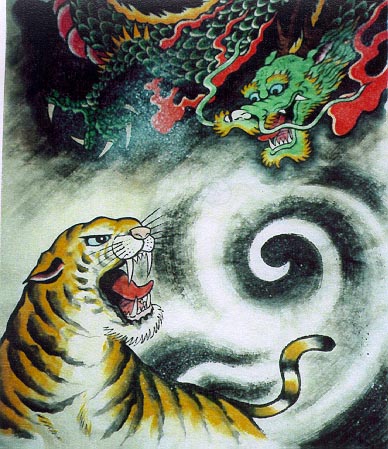
|
The monastic students of the Long-hu Ch'an Monastery were in the middle of copying a painting of a dragon fighting with a tiger on the wall. The dragon in the painting was hovering under the clouds; the tiger was crouched on a mountain summit, poised as if about to pounce. Although it had been revised numerous times, there invariably seemed to be something missing in the flow of action in the painting. Quite by chance, at this time Ch'an master Wu-te returned from outside. The students requested the Ch'an master to make a quick assessment of what they had done. After looking at it, Ch'an master Wu-te said: "The outlook of the dragon and the tiger hasn't been painted too badly, but how much do you know about the nature of the dragon and the tiger? What you should know is that before the dragon attacks its head must shrink backwards, just as when the tiger is pouncing upwards its head is bound to press downwards. The more the dragon's neck is bent backwards, and the closer the tiger's head is to the ground, the faster they will be able to rush forward and the higher they'll be able to jump."
The students were overjoyed to receive such an instruction, exclaimed: "The teacher really hit the nail on the head! Not only did we paint the dragon's head too far forward, but the tiger's head is also too high. No wonder we felt there was something lacking in the depiction of the action." Ch'an master Wu-te seized this opportunity to teach by saying: "In personal conduct, as well as in taking care of affairs, while learning Ch'an and cultivating oneself religiously, one must prepare by taking a step back in order to rush ahead even farther, reflecting humbly so that one can climb even higher." Apparently not completely following what was being told, the students asked: "Teacher, how is one who steps back able to move forward? How is one who humbles himself able to reach higher?" In response, Ch'an master Wu-te then solemnly said: "Listen to my Ch'an poem :
"Are you all able to comprehend?" By now all the students finally understood.
(Source: Hsing Yun's Ch'an Talk, Book 4) |









